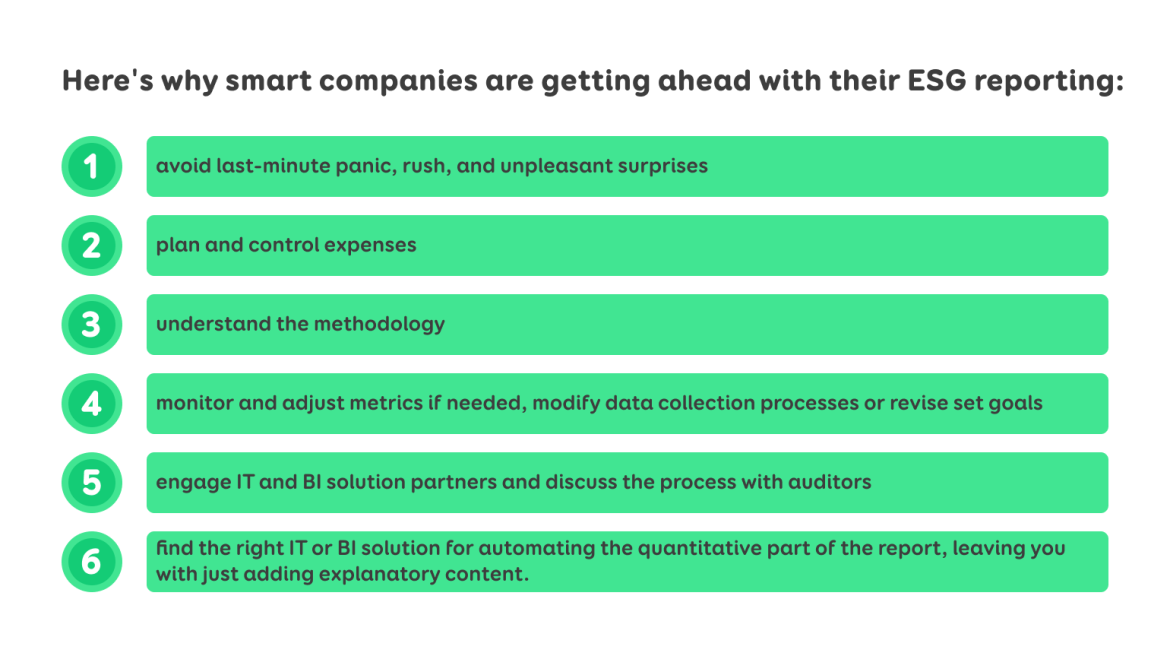Preparing for ESG (Sustainability) Reporting: The Role of Business Analytics and IT Solutions
From 2025, companies in Estonia need to start presenting ESG (Environmental, Social, Governance) sustainability reports as an addendum to the yearly financial report. At first glance, this may seem a vast and intricate subject, potentially overwhelming to many.
In this feature, we sit down with Siim Lassmann, Sales Director at our affiliate, Intelex Insights. We delve into the specifics of what this responsibility entails and identify those who will be affected by it. Further, we shed light on its implications for business proprietors and elucidate how harnessing IT and BI (Business Analytics) tools can greatly aid in navigating the ESG reporting landscape.
To mitigate the stress and potentially higher costs associated with last-minute preparations – especially if specialist intervention is warranted due to capacity constraints – we strongly advise businesses to start their preparations as soon as possible.
What is ESG Reporting and Who Should Do It?
Everyone is feeling the impact of significant environmental problems like global warming, waste, and water shortages. Because of this, the European Union is trying to make things better. One of the ways they plan to do this is by asking companies to share information about some key metrics concerning various areas of sustainability. This is called ESG reporting.
The idea is simple: if companies tell everyone how they're doing, they might try harder to be reduce their negative and increase positive impacts.
Hopefully, this helps the European Union to reach their target: to cut down harmful air pollution by 55% by 2030.
Why is Sustainability Reporting Important and What If You Skip It?
Sustainability reporting matters a lot. Here's why:
- It lets companies see how they're affecting our world, from the environment to people, helping them manage risks and find new opportunities to improve.
- More and more customers, business partners, and investors want to support green businesses. An ESG report can show shows them that the company takes these kinds of things seriously.
- To achieve any goal, you need to know your starting point. These reports help companies set targets for being more eco-friendly and track how well they're doing.
But what if a company doesn't provide a report? There could be problems:
- Their reputation might suffer.
- They might lose clients or investors. In fact, some companies in places like Scandinavia will only work with you if you show them your sustainability report.
Banks, including ones like Swedbank, are joining the movement too. They're looking for these reports when deciding whether to lend money. Banks want to see that a company isn't just talking about being green – they're actually doing it.
This includes following best practices, managing changes, checking the company and who they work with, getting others involved, and setting real, science-backed goals. If companies don't do this, banks might not offer loans or might charge more.
The sustainability reporting directive will apply from 2024 onwards, expanding gradually:
- From 1 January 2024 (first report published in 2025) to public interest entities with over 500 employees;
- From 1 January 2025 (first report published in 2026) to all large enterprises meeting at least two of the following criteria for two consecutive years:
- 250 or more employees;
- Sales revenue of €40 million;
- Balance sheet total of €20 million;
- From 1 January 2026 (first report published in 2027) to other listed companies (except micro-entities) and small and non-complex credit institutions. If necessary, there's a possibility for a two-year reporting postponement for listed SMEs, provided they give a valid reason in their report;
- From 1 January 2028 (first report published in 2029) to third-country entrepreneurs with a net turnover in the EU of over €150 million if they have at least one subsidiary or branch in the EU exceeding the threshold.
What Does This Mean for Businesses and How Can They Benefit?
Sustainability reporting might seem like extra work, but it can also be an opportunity. Here's how:
- By looking into sustainability, businesses can spot risks and opportunities that affect how well they do now and in the future. Understanding these risks means companies can plan better and prepare for what's coming. By sharing their report for everyone to see, businesses can also compare themselves against their competitors. This might show new ways to get ahead or avoid problems.
- Being green can make a company look good. Customers, business partners, potential employees, and investors will like it more. For example, if a company makes things in an efficient and environmentally friendly way, it can make them stand out. Plus, by focusing on sustainability, companies might find new ways to grow.
In places like Estonia, many businesses use "being green" as a selling point when hiring new people. We've also found that young workers like to join companies that care about the planet and are trying to reduce their harm to it.
How can IT and BI Solutions Simplify the Reporting Process?
Companies will need to add a sustainability report to their usual annual report every year. This will be done in the same electronic format all over Europe.
This report has to give an overview about various topics concerning sustainability:
- The environment: your carbon footprint, how you use resources, and how much waste you make.
- Society: how you treat people, how your workers feel, and how you work with customers and suppliers.
- Governance: how your company is run, risk management and your company values and ethics.
Now, it's true that this is a bit of extra work. Larger companies might find this costly. And it might not make your company better straight away.
But here's the good news: tech can make this job easier. To simplify the task, let’s look at the report from two perspectives. First of all, there are more or less qualitative topics, like the existence of whistleblower protection programs.
The second part can be thought of as quantitative metrics based on structured data that is produced during everyday processes. This is something, that can be relatively easily automated; this is basically what business intelligence solutions are designed to do.
For example, if you collect data about fuel purchases, then it’s quite easy to calculate how much CO2 is generated through burning gas. In the end, this means less manual work and better, real-time overview of your processes.
Where to Start with Automation?
Starting something new can sometimes be a bit frightening. In our experience, it's usually a good idea to break things down into smaller bits. Let's take an easy example from ESG reports. We already touched CO2 emissions a bit, so let’s go forward with that.
The topic in general is quite easily understood – when we use energy, when we drive with our cars and fly with planes, it creates CO2. Excess CO2 is considered harmful for the environment.
So, let’s map the main activites that generate CO2 and try to calculate how much CO2 emissions are generated. Electricity usage, natural gas usage, fuel consumption, office heating during the cold months and so on. There are ways to simplify the process, for example, calculating the CO2 equivalent (convert used natural gas into CO2 equivalent).
In essence, this is just data collection which can often be quite easily automated and, what is also important, that the topic is quite easy to understand and it’s easy to check if the solution is actually able to work independently.
In our experience, it’s often best to start smart. Pick the first issue to solve, validate your solution based on that small proof of concept and if it works as advertised, then you can confidently move forward with more complex issues.
And, of course, it is also always helpful to plan enough time to achieve desired outcomes, as rushing at the last hour can reduce the quality and make the solution more expensive.
Developing the process involves considering data sources, data collection methods, and planning. For instance, many partners of our affiliated company Intelex Insight, which provides BI solutions, already monitor their CO2 emissions and resource usage. In doing so, they've identified data quality issues and made necessary changes to make future monitoring more efficient. With no pressing deadlines, one can handle this alongside other tasks.
Early preparation allows companies to understand the nuances of the calculation process and the necessary steps, develop methodologies that facilitate reporting, involve IT and BI solution partners, and discuss the process with auditors early on.
Last-minute solutions can be costly and complicated, as suitable advisors, IT and BI solution providers might be overburdened or their quotes too expensive. As Intelex Insight's sales manager Siim Lassmann stated, at the start of a project it is often time that is wasted, but towards the end, it becomes money that is wasted. Therefore, prevention and preparation are the keys to smooth and cost-effective reporting.
In Conclusion
In less than 2 years, sustainability reporting (ESG) will become mandatory for European companies. While at first glance, it might seem like a huge investment of time, money, and nerves, burying one's head in the sand won't improve the situation. On the bright side, as highlighted in this article, one can find opportunities for better risk mapping or even improving competitiveness.
Starting early allows companies to think thoroughly about reporting, automate necessary processes, and develop methodologies. This helps keep costs reasonable during the reporting period and avoids last-minute stress and surprises.









